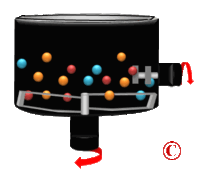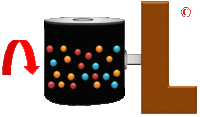- Industrial mixer
-
Industrial Mixers and Blenders are used to mix or blend a wide range of materials used in different industries including the food, chemical, pharmaceutical, plastic and mineral industries. They are mainly used to mix different materials using different types of blades to make a good quality homogeneous mixture. Included are dry blending devices, paste mixing designs for high viscosity products and high shear models for emulsification, particle size reduction and homogenization.
Industrial mixers range from laboratory to production line scale, including Ribbon Blender, V Blender, Cone Screw Blender, Screw blender, Double Cone Blender, Double Planetary High Viscosity Mixer, Counter-rotating, Double & Triple Shaft, Vacuum Mixer, Planetary Disperser, High Shear Rotor Stator and Dispersion Mixers, Paddle, Jet Mixer, Mobile Mixers and Drum Blenders. The Banbury mixer is effective at mixing or kneading viscous materials.
They can operate at different temperatures and pressures for mixing different solutions and can also have internal or external heating systems added to them. Options also exist where spray nozzles, CIP, PLC and pneumatic or electric systems can be used. Systems can come equipped with hydraulic or electronic soft start mechanisms so that they start and stop smoothly.
Contents
Basic Nomenclature
For liquid mixing, the nomenclature is rather standardized:
- Impeller Diameter, "D" is measured for industrial mixers as the maximum diameter swept around the axis of rotation.
- Rotational Speed, "N" is usually measured in revolutions per minute(RPM) or revolutions per second(RPS). This variable refers to the rotational speed of the impeller as this number can differ along several points of the drive train.
- Tank Diameter, "T" The inside diameter of a cylindrical vessel. Most mixing vessels receiving industrial mixers will be cylindrical.
- Power, "P" Is the energy input into a system usually by an electric motor or a pneumatic motor
- Impeller Pumping Capacity, "Q" The resulting fluid motion from impeller rotation.
Mixing Calculations
The level of mixing is determined by the pumping effect or dynamic response that the mixer imparts into the fluid. When a mixing impeller rotates in the fluid, it generates a combination of flow and shear. The impeller generated flow can be calculated by using the following equation:
- Flow (GPM) = (Flow_Number * RPM * Impeller_Diameter^3) / 231
To calculate power draw, use the following equation:
- Power (HP) = (Power_Number * RPM^3 * Impeller_Diameter^5 * Fluid_Specific_Gravity) / (1.525 * 10^13)
Flow Numbers and Power Numbers for impellers have been published by the North American Mixing Forum, Post Mixing, and Fusion Fluid Equipment. An online mixing calculator is available http://www.fusionfluid.com/html/Knowledge-MixingCalculator.htmlSee also
- Mixing (process engineering)
- Planetary mixer
- Static mixer
- Banbury mixer
Sources
Categories:- Industrial machinery
Wikimedia Foundation. 2010.






